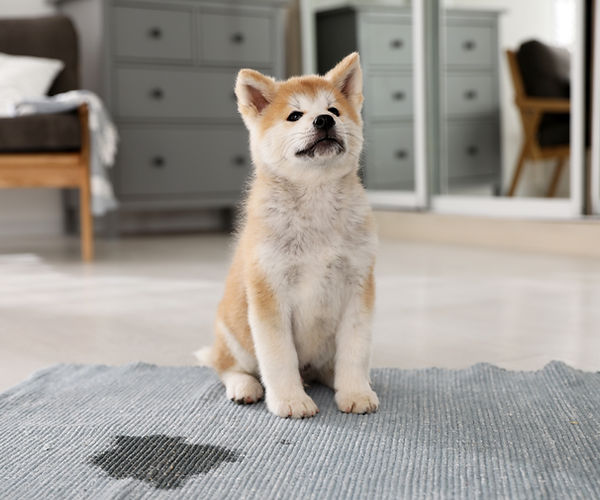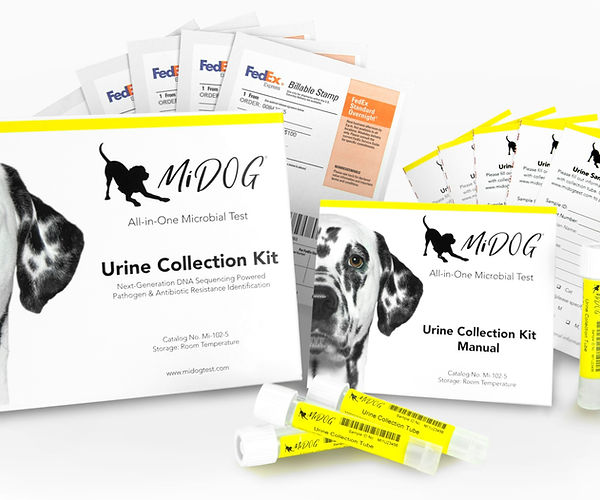
MiDOG can help detect the cause of your dog’s urinary tract infection for a better treatment plan.
The neighborhood fire hydrant, that lamp post with some certain joie de vivre, and that favorite patch of grass have all become experts in your dog’s urine. If your dog seems to be visiting their local bathroom more often than normal, perhaps it’s time you become an expert too! Urinary tract infections (UTIs) are painful and if left untreated can result in dangerous urogenital complications, and so early identification and intervention are beneficial.
What Is a UTI?
Canine UTIs are fairly common and occur in approximately 14% of dogs throughout their lifetime [1]. While the majority of UTIs are a result of pathogenic bacteria ascending external genitalia and the urethra, contemporary research has started to shift away from attributing UTIs to solely one pathogenic organism. Instead, a more complex relationship between the polymicrobial nature of the urinary tract and its interactions with the canine host can have significant implications on UTI manifestation and severity [2]. It is important to note that one organism can still be the primary culprit to your dog’s UTI, but the interactions with your dog’s urinary microbiome can play an important role as well.
What Is the Urine Microbiome?
Your dog’s urinary tract is composed of a microbiome, meaning the collective genomes of all types of microbes including bacteria, bacteriophage, fungi, protozoa, and viruses. This microbiome and its specific composition can actually be an indicator of your pup’s health status. For example, an imbalanced microbiome, or so-called “dysbiotic state”, can result in an environment conducive to a UTI manifestation [3]. Opportunistic pathogens can thrive and multiply in such an imbalanced urinary microbiome. Capturing the microbiome composition in a dog urine sample is technically quite challenging. Traditional diagnostic tools like culture and PCR can only detect a few microbes, but contemporary diagnostic tools provide a unique clinical application for dogs suffering from chronic or even acute UTIs.
The opportunistic bacteria most frequently involved in canine UTIs include the Gram-negative bacteria like Escherichia sp., Proteus sp., Klebsiella sp., Enterobacter sp., Pseudomonas sp., Mycoplasma sp., and Ureaplasma sp. and the Gram-positive cocci Streptococcus sp. and Staphylococcus sp. [4]. Pathogenic bacteria can cause inflammation in the urinary tract, and can even go on to cause stones to develop in the bladder [3]. In some cases where UTIs are not identified and treated soon enough, the infection may even spread to the kidneys and prostate [3].

A house-broken dog uncharacteristically urinating in inappropriate areas may be a sign your dog has a UTI.
Dog UTI Symptoms:
There is a spectrum of UTI severity that can range from being mild to potentially life-threatening. So knowing the warning signs of a UTI is very important. Older female dogs and diabetic dogs are particularly prone to urinary tract infections. Here are the most common symptoms associated with canine UTIs:
- Increase in frequency of urination
- Strain in urination
- Strong odor in urine
- Bloody or cloudy urine
- Frequent licking of genitals
- Crying out in pain when urinating
- Loss of bladder control
Dog UTI Treatment
If you think your dog may have a UTI, the best thing you can do is get a quick and accurate diagnosis from your vet as soon as you notice symptoms. Getting started on an antibiotic treatment plan tailored to the severity and strain of your dog’s UTI is important [5]. In severe cases, your dog could need immediate medical intervention.
Dog UTI Diagnostics: Conventional versus Contemporary
Considering the importance of understanding the severity of your dog’s UTI, diagnostic tools are critical in delivering quality clinical care. Although culture-based urinalysis has historically been lauded as the convention for UTI diagnosis, scientific research has provided increasing evidence for the diagnostic benefits of Next-Gen sequencing (NGS) technology. Conventional urinalysis has significant limitations in sensitivity to various microorganisms, as many remain undetected by culture methods [2].
Some examples of these organisms are Mycoplasma sp., and Ureaplasma sp. The inability for culture-based urinalysis to detect various microorganisms can result in “no growth” cultures despite symptomatic UTI presentations [2]. A recent study has highlighted that even in cases where a UTI was confirmed, up to 64% of all culture tests return with the “no growth” results [6]! This issue can delay the treatment of your dog and is particularly problematic in cases of antibiotic-resistant strains of opportunistic pathogens [7]. Having the diagnostic knowledge to assign appropriate medical intervention is key and is needed quickly.
A collaboration between Western University School of Veterinary Science and MiDOG has recently shown how contemporary diagnostic tools can be used to advance our knowledge about dogs’ urine and health status. This is the first study to show that there is a microbiome present in your dog’s urine, even when your pup is perfectly healthy. This highlights that dog urine is not sterile, even if the culture testing results come back with” no growth”. Read the study here to learn more.
The MiDOG All-in-One Microbial test utilizes the same NGS technology as described in the study to detect and quantify all microbial DNA through untargeted and comprehensive sequencing and quantitative comparisons to reference databases [2]. Considering urine is non-sterile in both health and disease states, the MiDOG NGS technology provides a useful opportunity to shed light on the microbial makeup of your dog’s urine for clinical application [2,8]. The MiDOG microbial test is grounded on scientific research that provides veterinarians DNA evidence for the guided treatment of canine infections, such as UTIs.
The MiDOG All-in-One Test has helped veterinarians treat even the most chronic UTIs in the past. Read a case study to learn more.

The MiDOG Urine Collection Kit may be the solution to your dog’s urinary tract infections.
Find out if your vet uses MiDOG before you book your next appointment!
References:
[1] Ling, G., 1984. Therapeutic strategies involving antimicrobial treatment of the canine urinary tract. J Am Vet Med Assoc., 185, pp.1162–1164.
[2] Melgarejo, T., et al., 2021. Canine Urine Microbiome: Assessment of Bacterial and Fungal Populations in Clinically Healthy Dogs Using Next-Generation-Sequencing. Journal of Veterinary Internal Medicine. IN PRESS
[3] Thompson, M., Litster, A., Platell, J. and Trott, D., 2011. Canine bacterial urinary tract infections: New developments in old pathogens. The Veterinary Journal, 190(1), pp.22-27.
[4] Penna, B., Varges, R., Martins, R., Martins, G., & Lilenbaum, W., 2010. In vitro antimicrobial resistance of staphylococci isolated from canine urinary tract infection. The Canadian veterinary journal = La revue veterinaire canadienne, 51(7), 738–742.
[5] Jessen, L., Sørensen, T., Bjornvad, C., Nielsen, S. and Guardabassi, L., 2015. Effect of antibiotic treatment in canine and feline urinary tract infections: A systematic review. The Veterinary Journal, 203(3), pp.270-277.
[6] Acierno, M., et al., 2018. Effect of refrigeration of clinical canine urine samples on quantitative bacterial culture. J Am Vet Med Assoc., 253(2), pp.177-180.
[7] Hall, J., Holmes, M. and Baines, S., 2013. Prevalence and antimicrobial resistance of canine urinary tract pathogens. Veterinary Record, 173(22), pp.549-549.
[8] Burton, E., Cohn, L., Reinero C., et al. 2017. Characterization of the urinary microbiome in healthy dogs. PLoS One, 12: e0177783.
Categories: Dogs, Next-Gen DNA Sequencing Technology, Pet Health, Safety and Wellness, Pet Parents, Urinary Tract Infection (UTI)

